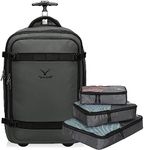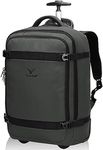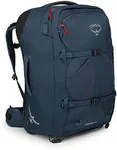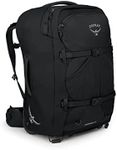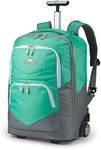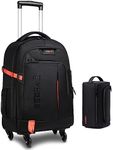Buying Guide for the Best Rolling Travel Backpacks
Choosing a rolling travel backpack is all about finding the right balance between comfort, convenience, and capacity. These bags are designed to give you the flexibility of both rolling luggage and a backpack, making them ideal for travelers who may encounter a mix of smooth airport floors and rougher terrain. To pick the best one for you, it's important to understand the key features and how they relate to your travel style and needs.Capacity (Liters)Capacity refers to how much the backpack can hold, usually measured in liters. This is important because it determines how much you can pack. Smaller capacities (under 40L) are great for short trips or as carry-ons, while medium (40-60L) work well for week-long travels, and larger sizes (over 60L) are best for extended trips or if you need to carry a lot. Think about how long your trips usually are and how much you typically pack to choose the right size for you.
Wheel Quality and TypeThe wheels are what make these backpacks easy to roll, so their quality matters for durability and smooth movement. Larger, sturdy wheels handle rough surfaces better, while smaller wheels are fine for mostly indoor or smooth surfaces. If you expect to walk on uneven ground, look for larger, rugged wheels. If you’ll mostly be in airports and hotels, smaller wheels may be sufficient.
Backpack Straps and HarnessSince these bags can be carried as backpacks, the comfort and design of the straps and harness are important. Well-padded, adjustable straps and a supportive back panel make carrying the bag easier, especially when it’s heavy. Some models have stowable straps that tuck away when not in use, which is handy for rolling. If you expect to carry the bag for long periods, prioritize comfort and adjustability.
Handle SystemThe handle system is what you use to pull the bag when rolling it. A sturdy, telescoping handle that locks at different heights is ideal for comfort and control. If you’re taller or shorter than average, check that the handle extends to a comfortable length for you. A well-designed handle also makes it easier to maneuver the bag in crowded spaces.
Weight of the BackpackThe empty weight of the backpack affects how much you can carry and how easy it is to lift or wear. Lighter bags are easier to carry but may have fewer features or less durability, while heavier bags might be sturdier but harder to manage. Consider your own strength and how much you’ll need to lift or carry the bag when choosing the right weight.
Compartments and OrganizationGood organization helps you keep your belongings tidy and easy to access. Look for backpacks with multiple compartments, pockets, and dividers. Some have special sections for laptops, shoes, or toiletries. If you like to keep things organized or travel with electronics, prioritize bags with thoughtful internal layouts.
Material and DurabilityThe material of the backpack affects its durability and weather resistance. Strong, water-resistant fabrics like nylon or polyester are common and help protect your belongings. If you travel in rough conditions or want a bag that lasts, look for reinforced corners, quality zippers, and tough materials.
Size and Carry-On CompatibilityIf you want to use your rolling backpack as a carry-on, check its dimensions against airline requirements. Some bags are specifically designed to fit in overhead bins, while others may be too large. If you fly often and want to avoid checked baggage, make sure the bag meets most airlines’ carry-on size limits.
